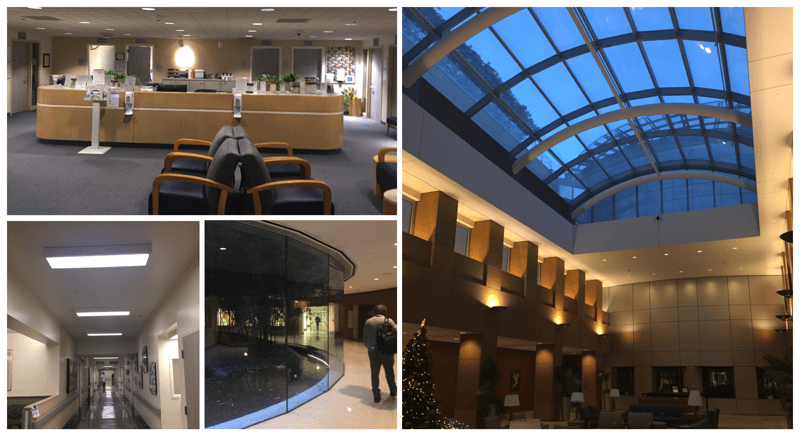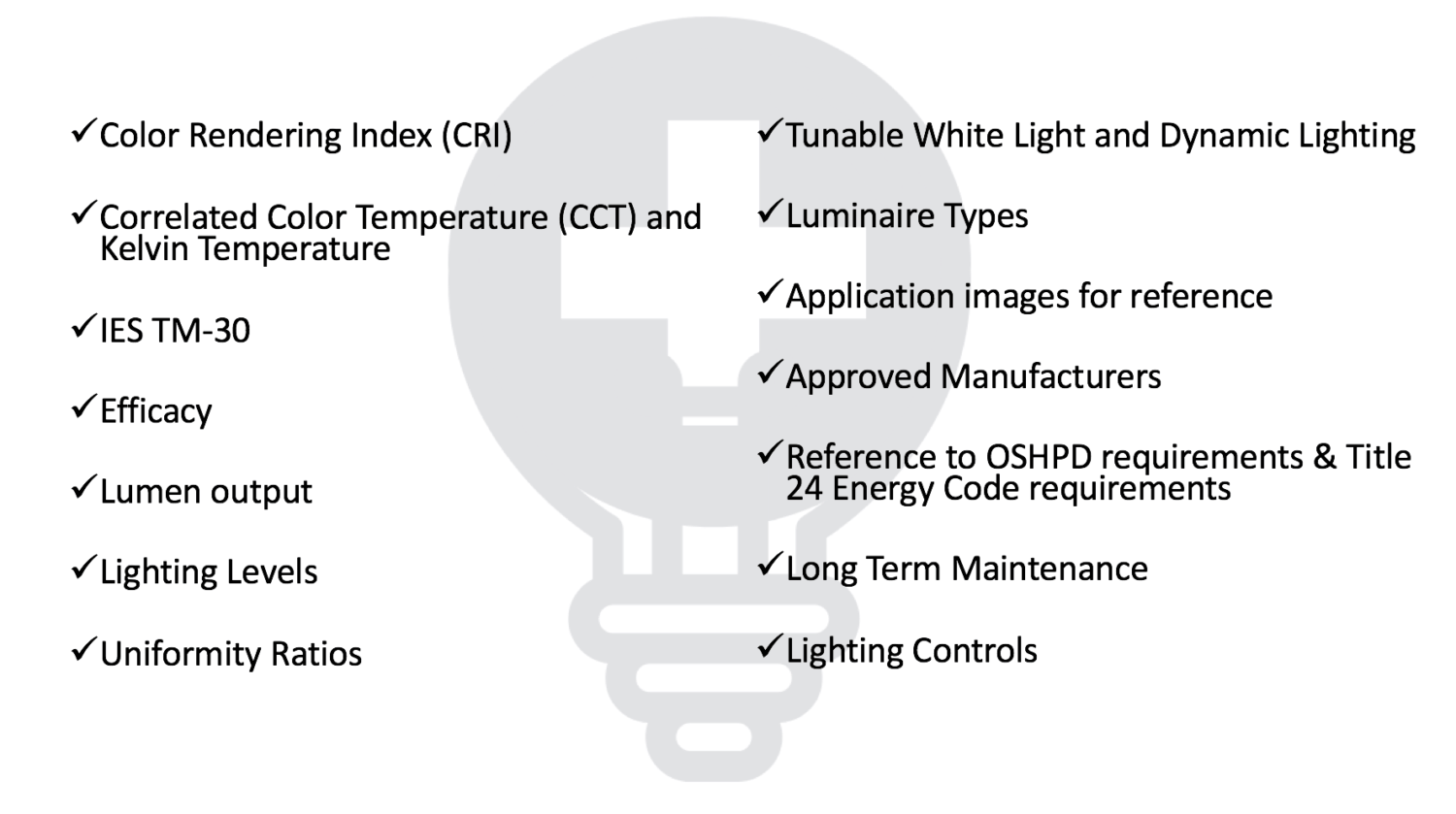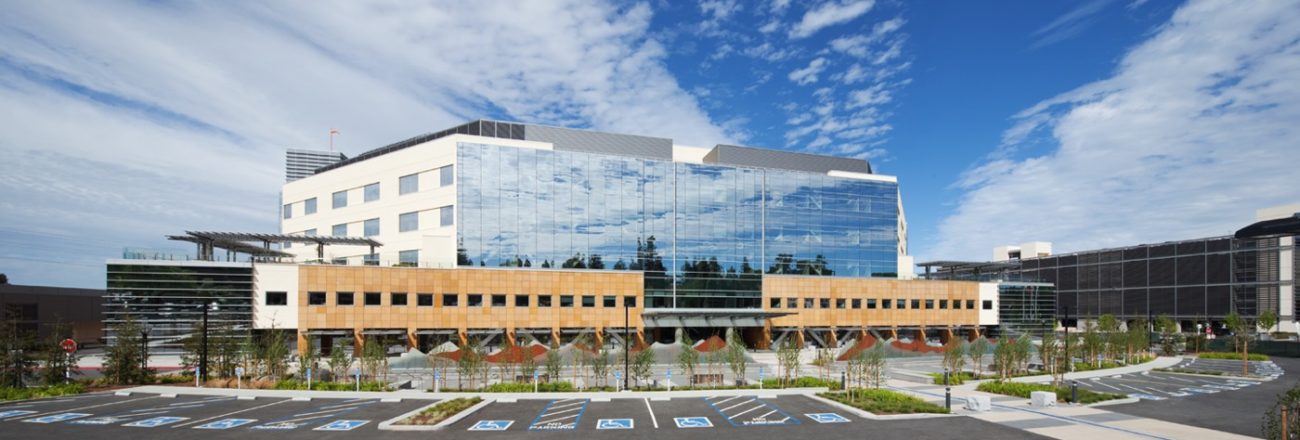Background:
Over time, growing healthcare systems without design standards will naturally manifest noticeable inconsistencies, particularly when it comes to lighting. (Similar to any organization, increasing in size typically warrants a greater need for standardization and increased clarity.) Consider when you’ve experienced a healthcare lobby and while venturing to the patient room, felt the unmistakable discontinuity as your visual environment alters dramatically. John Muir Health (JMH), an expanding not-for-profit based east of San Francisco, started experiencing this inconsistency with their own lighting. In particular, as LED technology has significantly advanced over the years, facilities with the older generation LED lighting were literally glaringly different compared to newer facilities with upgraded LED technology. When you’re in the business of wellness and healing, the physical (visual) environment must be a priority — JMH recognized this priority and sought assistance to standardize lighting design for existing and new facilities.
“We knew we needed a consistent look and feel as we continue to expand and renovate spaces, particularly given recent advances in lighting technology. We needed to be able to tell designers, for new projects, the type of luminaire and lighting design per specific performance criteria.”
- Peter Spadia, JMH Senior Project Manager for Facilities Development.
“After a recent build-out, not incorporating higher tech controls for lighting, we knew we needed to take action toward resolving this systemically,” said Peter.
Earlier this year, an opportunity emerged from an Outpatient Center (OPC) project, yielding extra design capital – this was it!
Having a long-tenured relationship with Mazzetti for various MEP design and now lighting design needs, JMH contracted with Mazzetti. The mission was set. JMH needed:
- Performance metrics and criteria for a variety of spaces including new construction, LED retrofits and “one for one” replacements.
- Increased quality of visual environment for staff, patients, and family by building consistency in the lighting systems.
- Streamlined maintenance and access to information regarding the lighting systems.
A significant piece of the maintenance objective involved JMH’s internal engineers. They needed a map/guidelines for relamping and other maintenance, as well as trusted manufacturer recommendations.
JMH established the following comprehensive goals:
- Carefully integrate electric lighting and lighting control systems with daylight, architecture and interiors, to create an enjoyable and aesthetically pleasing visual experience.
- Provide lighting and control systems that are specifically designed to align with human circadian cycles, promoting the health and well-being of patients, staff and family, while improving patient recovery.
- Create lighting systems that are visually comfortable while supporting the wide range of visual needs, tasks, and special requirements within the facility.
- Design lighting systems utilizing current technology that can respond to future changes in the healthcare industry by being flexible, adaptable, energy efficient, long-lived and easy-to-maintain.
- Include the design team and owner, develop lighting design options that can be evaluated based on the owner’s requirements, lighting performance metrics, visual quality, aesthetics, maintenance, and cost.
- Establish lighting budgets and performance criteria that can be tracked to ensure that goals are being met; enable the owner and design team to make (more) informed decisions on the lighting system.
- Engage the owner, patients, and staff via mockups, sharing current issues on light and health and various design concepts for input on how to meet the needs and wants of the users.
Action:
Mazzetti jumped into action, working closely with JMH staff. First step was discovery — evaluating lighting conditions at existing JMH facilities. Mazzetti toured existing facilities to evaluate pre-existing lighting and received input from staff regarding their lighting needs.

Site visit photos — Mazzetti investigating the current lighting conditions.
The JMH facilities assessments involved:
- Gathering and reviewing As-Builts if available, printing floor plans for each space to be evaluated.
- Evaluating existing conditions that impact the visual environment, documenting each with notes and photographs.
- Taking illuminance readings in each space, or typicals.
- Noting reflectances and other lighting quality issues such as glare, contrast, and uniformity issues.
- Noting lamps and luminaire types, including manufacturer data for reference on typical fixtures.
- Meeting with maintenance/facilities to discuss current relamp/retrofit replacement approach.
- Discussing lighting conditions with staff and building users.
- Discussing lighting control use, manufacturers, likes/dislikes with JMH, noting areas needing improvement, including exterior.
What was discovered through these evaluations and conversations?
Maintenance staff would often replace lighting without knowledge of color temperature, CRI, lumen output, etc. In addition, clinical staff expressed concerns over not knowing how to control the lighting, much less the intended functionality for optimal operations.
Mazzetti spent two days with JMH staff reviewing and evaluating current lighting to produce a lighting audit report. This report included existing documentation, including a lamp list; calculating existing lighting power densities and current energy usage; calculating energy savings, ROI, and possible paybacks with various strategies. This was augmented with narrative, including goals for the future.
Results:
JMH is now equipped with lighting design standards and guidelines plus design strategies for each space, including bringing existing spaces to current standards:
- Relamp, Retrofit kits or One-for-One Replacement
- Renovations
- New Design
Mazzetti crafted NEW lighting design standards addressing the following criteria:
 The new standards and guidelines include brief space descriptions, lighting metrics for the quality and quantity of light, design recommendations, and luminaire and control recommendations to build the much-desired consistency in the lighting systems across the JMH campuses, including off-site facilities. The lighting design recommendations include a basis of design for luminaire and control selection, highlighting any coordination issues depending on the application. Regarding maintenance, JMH now has a trusted lighting replacement go-to matrix for facilities staff to use on new LED lamps or retrofit kits. This addresses recommendations for ongoing maintenance ranging from simple lamp replacement, to luminaire replacement, to new design and construction projects.
The new standards and guidelines include brief space descriptions, lighting metrics for the quality and quantity of light, design recommendations, and luminaire and control recommendations to build the much-desired consistency in the lighting systems across the JMH campuses, including off-site facilities. The lighting design recommendations include a basis of design for luminaire and control selection, highlighting any coordination issues depending on the application. Regarding maintenance, JMH now has a trusted lighting replacement go-to matrix for facilities staff to use on new LED lamps or retrofit kits. This addresses recommendations for ongoing maintenance ranging from simple lamp replacement, to luminaire replacement, to new design and construction projects.
Benefits:
JMH is gearing up for a significant retrofit design project, for which, Mazzetti is providing the MEP design.
“We’re looking forward to implementing these new standards and reaping the benefits,” said Spadia. I’m grateful to have worked with the Mazzetti team on this effort. I appreciate their knowledge and enthusiasm… they’re just fun to be around and very good at what they do! This work will ultimately benefit our patients, visitors, physicians and staff.”
This will be the first official project using the new standards. The anticipated benefits will include facilities with warmer, more visually pleasing lighting with better patient and staff control. Lighting will have more consistency, energy efficiency, and will (better) aid in patient and staff satisfaction.
References:
Mazzetti referenced a variety of codes, guidelines, and industry standards while developing the lighting design standards/guidelines including:
- Title 24 – www.energy.ca.gov/title24/
- Illuminating Engineering Society of North America (IESNA) – www.ies.org
- Office of Statewide Health Planning and Development (OSHPD) – https://oshpd.ca.gov/
- Facilities Guidelines Institute – www.fgiguidelines.org
- The American Society for Health Care Engineering of the American Hospital Association (ASHE) – www.ashe.org
Discover more about Mazzetti’s Lighting Design Studio here.
Interested in what you see? Subscribe to receive monthly news and information
more tailored to what you need.


